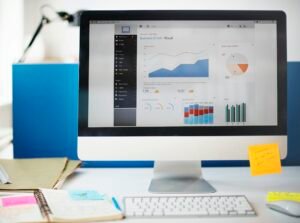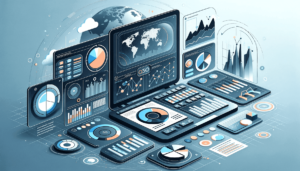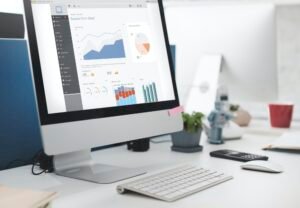Introduction: How Tableau is transforming digital marketing
Tableau is a powerful data visualization and analytics tool that has revolutionized how digital marketers analyze and interpret data. With its user-friendly interface and robust features, Tableau has become a game-changer for marketers looking to make data-driven decisions and improve their marketing strategies. In this article, we will explore the role of data visualization in digital marketing, Tableau’s capabilities in data analysis and visualization, and how Tableau helps marketers make better decisions.
The role of data visualization in digital marketing
Data visualization is crucial in digital marketing as it helps marketers understand complex data sets and make informed decisions. In today’s digital landscape, marketers can access vast amounts of data from various sources, such as website analytics, social media platforms, customer databases, and more. However, raw data alone is not enough to derive meaningful insights. This is where data visualization comes into play.
By visualizing data through charts, graphs, and interactive dashboards, marketers can easily identify trends, patterns, and correlations that may not be apparent in raw data. Data visualization allows marketers to see the big picture and better understand their target audience, customer behavior, and market trends. It enables them to communicate complex information effectively and make data-driven decisions that drive business growth.
Unleashing the power of data with Tableau
Tableau is a leading data analysis and visualization tool that empowers marketers to unleash the power of their data. With its intuitive drag-and-drop interface and powerful analytics capabilities, Tableau makes it easy for marketers to explore, analyze, and visualize their data in real time. Whether it’s analyzing website traffic, social media engagement, or customer demographics, Tableau provides marketers with the tools they need to gain actionable insights from their data.
Tableau’s capabilities go beyond basic data visualization. It allows marketers to connect to multiple data sources, clean and transform data, and create interactive dashboards and reports. With its advanced analytics features, marketers can perform complex calculations, predictive modeling, and statistical analysis to uncover hidden insights and make data-driven decisions. Tableau also offers collaboration and sharing features, allowing marketers to collaborate with team members and share their findings with stakeholders.
How Tableau helps marketers make better decisions
Tableau’s data visualization tools help marketers identify trends and patterns that can inform their marketing strategies. For example, marketers can use Tableau to analyze website traffic data and identify which pages or campaigns drive the most conversions. Visualizing this data allows marketers to optimize their website design, content, and marketing campaigns to improve conversion rates.
Tableau’s real-time data analysis capabilities are particularly valuable for marketers who need to make informed decisions quickly. With Tableau, marketers can connect to live data sources and visualize real-time data in interactive dashboards. This allows them to monitor key metrics, track campaign performance, and make adjustments on the fly. For example, if a marketing campaign is not performing as expected, marketers can quickly identify the issue through Tableau’s visualizations and take corrective action.
Using Tableau to analyze customer behavior and preferences
Understanding customer behavior and preferences is essential for effective marketing. Tableau’s data visualization tools help marketers gain insights into customer behavior by analyzing customer data from various sources, such as CRM systems, transactional databases, and social media platforms.
For example, a retailer can use Tableau to analyze customer purchase history and identify patterns in buying behavior. By visualizing this data, the retailer can segment customers based on their preferences and create targeted marketing campaigns that resonate with each segment. This personalized approach can lead to higher customer engagement and conversion rates.
Tableau’s customer analysis tools also allow marketers to track customer sentiment on social media platforms. By analyzing social media data in real time, marketers can identify trends, monitor brand sentiment, and respond to customer feedback promptly. This helps marketers improve their social media marketing strategies and build stronger customer relationships.
Streamlining marketing campaigns with Tableau’s data integration
Tableau’s data integration capabilities help marketers streamline their marketing campaigns by combining data from various sources into a unified view. With Tableau, marketers can connect to multiple data sources, such as CRM systems, email marketing platforms, and advertising platforms, and integrate the data into a centralized dashboard.
By integrating data from different sources, marketers can gain a holistic view of their marketing campaigns and track performance across channels. For example, a marketer can use Tableau to analyze the effectiveness of an email marketing campaign by integrating data from the email marketing platform with data from the website analytics platform. This allows the marketer to see how many recipients opened the email, clicked on links, and purchased on the website.
Tableau’s data integration capabilities also enable marketers to automate data updates and refreshes, saving time and effort. Instead of manually importing and updating data, marketers can set up automated data connections in Tableau that pull in new data as it becomes available. This ensures that marketers always have access to the most up-to-date information for their analysis and decision-making.
Visualizing social media data with Tableau
Social media has become integral to digital marketing strategies, and Tableau’s data visualization tools help marketers understand social media trends and patterns. With Tableau, marketers can connect to social media platforms such as Facebook, Twitter, and Instagram and visualize social media data in real-time.
For example, a marketer can use Tableau to analyze social media engagement metrics such as likes, comments, shares, and mentions. By visualizing this data, the marketer can identify which types of content resonate with their audience and optimize their social media strategy accordingly. They can also track the performance of social media campaigns and measure the impact of social media on website traffic and conversions.
Tableau’s social media data visualization tools also allow marketers to monitor brand sentiment on social media platforms. Marketers can identify potential issues or opportunities by analyzing social media mentions and sentiment scores and taking appropriate action. For example, if a negative sentiment is detected, marketers can respond quickly and address the issue before it escalates.
Leveraging Tableau to create personalized marketing experiences
Personalization is key to effective marketing, and Tableau’s data analysis and visualization tools help marketers create personalized marketing experiences for customers. Marketers can gain insights into customer preferences, behaviors, and needs by analyzing and visualizing customer data in Tableau.
For example, an e-commerce retailer can use Tableau to analyze customer purchase history and identify cross-selling and upselling opportunities. By visualizing this data, the retailer can recommend relevant products to customers based on their past purchases, increasing the likelihood of a sale.
Tableau’s data visualization tools enable marketers to create personalized dashboards and reports for stakeholders. For example, a marketing manager can use Tableau to create a dashboard that shows key performance metrics such as website traffic, conversion rates, and RO
This allows the manager to track the effectiveness of marketing campaigns and make data-driven decisions.
Measuring marketing ROI with Tableau’s analytics capabilities
Measuring marketing ROI is essential for evaluating the effectiveness of marketing campaigns and allocating resources effectively. Tableau’s analytics capabilities help marketers measure their marketing ROI by providing the tools to analyze campaign performance and track key metrics.
For example, marketers can use Tableau to analyze advertising campaign data and calculate metrics such as cost per click (CPC), cost per acquisition (CPA), and return on ad spend (ROAS). Visualizing this data allows marketers to identify which campaigns generate the highest ROI and optimize their advertising budget accordingly.
Tableau’s analytics tools also allow marketers to perform advanced calculations and predictive modeling to forecast future campaign performance. For example, marketers can use Tableau to analyze historical sales data and predict future sales based on different marketing scenarios. This helps marketers make data-driven decisions and allocate resources effectively to maximize ROI.
Conclusion: Why Tableau is a game-changer for digital marketers
In conclusion, Tableau transforms digital marketing by providing marketers with powerful data analysis and visualization tools. With its intuitive interface, robust features, and real-time capabilities, Tableau empowers marketers to make data-driven decisions, understand customer behavior, streamline marketing campaigns, and measure marketing ROI.
Tableau’s data visualization tools help marketers identify trends and patterns in complex data sets, enabling them to make informed decisions that drive business growth. Its integration capabilities allow marketers to combine data from various sources into a single view, streamlining marketing campaigns and improving efficiency. Tableau’s social media data visualization tools help marketers understand social media trends and sentiment, enabling them to optimize their social media marketing strategies.
Furthermore, Tableau’s analytics capabilities help marketers measure their marketing ROI and forecast future campaign performance. By leveraging Tableau’s data analysis and visualization tools, marketers can create personalized customer marketing experiences, improving customer engagement and loyalty.
In today’s data-driven world, Tableau is a must-have tool for digital marketers looking to improve their marketing strategies. Its ability to simplify the process of data analysis and visualization makes it accessible to marketers of all skill levels. With Tableau, marketers can unlock the power of their data and gain actionable insights that drive business success.
If you’re looking to enhance your digital marketing efforts with the power of data visualization, you may want to check out Studio Insighters’ article on “CMO Dashboards: A Comprehensive Guide.” This informative piece provides valuable insights on creating effective dashboards using tools like Tableau. From understanding key metrics to visualizing data meaningfully, this article offers practical tips and strategies for optimizing your digital marketing campaigns. To learn more, click here.







